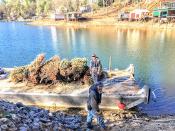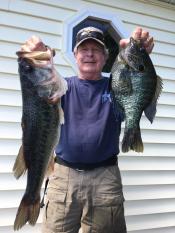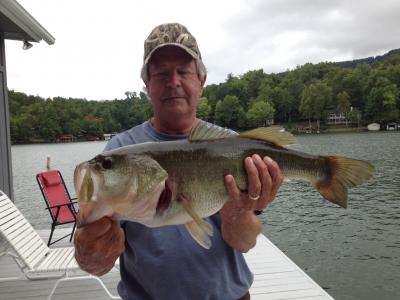2023 Lake Lure Fishing Study
Series of Studies Show Plan Has Improved Bass Growth
By Gary Hasenfus, Lake Advisory Board
The 2023 Fish Study is in and the Lake Lure fishery is alive and well! Lake Lure is presently functioning as a dynamic fishery, filled with bass!
The Town of Lake Lure began conducting formal fishery studies in 2007 to create a baseline of data for further study and ongoing lake management. Four assessments have been completed, providing the Town with a broad database from which future plans can be developed. The Town has sponsored four detailed Lake Studies in 2007, 2011, 2018, and in May of 2023.
The Town purchased Lake Lure in 1965 and depended upon the North Carolina Wildlife Resources Commission (NCWRC) to stock a variety of trout. After years of stocking trout, the NCWC discontinued the practice in 1979 once it was confirmed that trout could not survive the Lake’s high water temperatures in late summer and fall.
From 1990 through 2006 Rainbow Trout were stocked in a Town sponsored “release and catch” program. Most of these fish were caught during the winter and early spring months with the remainder experiencing high mortality in late summer due to a lack of adequate oxygen.

The 2007 assessment recommended a strategy to promote the Lake’s Black Bass population by adding additional habitat in the form of Christmas trees and the introduction of Threadfin Shad as supplementary forage.
Lake studies continued in 2011, 2018, and 2023. The same research design was using electrofishing, a scientific survey method used to sample fish populations to determine abundance, density and species composition. Additionally, fish examinations were conducted to determine length and weight. Some Largemouth Bass were sacrificed to remove their otolith, a bony structure at the base of the spine which determines the age of the fish. The 2011 otolith data revealed a typical 14-in Largemouth Bass was six years of age. In an ideal environment, the six years could be reduced to two or three.
The 2011 Fish Study provided a solid baseline for age to compare to the 2018 assessment. A dramatic reduction was noted regarding the length of time it was taking to grow a 14 inch Largemouth Bass. The sixth year was reduced to under four years which showed tremendous progress! The seven years between studies included increased habitat and forage as continued strategies to improve the fishery.
The strategy developed in 2007 has been continued every year by placing 100 or more Christmas trees in the Lake for habitat enhancement and the Town stocks Threadfin Shad for supplemental forage. In the 2023 Fish Study, the same methods were used as prior studies. This year's study was impacted slightly in that the Lake was not at full pond until late April 2023. During the 2018 assessment, the closest baseline, the Lake was at full pond on March 15, 2018. This difference may have reduced the number of bass recorded from 128 to 102.
The results of the May 2023 study were similar to 2018. Of course, the outstanding results of the 2018 study was compared to the 2011 numbers, which reflected increased weights in all Bass in the 11 to 14 in. class. The seven year period between studies reflected positive results in growth, length, and weight. Only 5 years separated the 2018 and 2023 studies providing fewer years to measure progress.
- A better range of size was noted this year. The ideal balance of the 14 to 18 in. class of Black Bass is 51% of the population.
- The current Lake balance for the 14 to 18 in. class of Black Bass was 37% in 2018 and 38% in 2023.
- This does not represent a significant change but still represents a sign of progress.
- With regard to tagging bass for future data, 21 fish were tagged this year and 12 were tagged in 2018.
- It is important to reporting a tagged fish to the Town or Southeastern Pond
- If you catch a tagged fish, note the phone number on the tag along with the tag number, weight, and length.
- Please do not return the tagged fish to the Town or to Southeastern Pond.
- Research will be served if the bass is returned to the Lake unharmed.

Summary and comments:
Lake Lure faces some challenges when it comes to a perfect environment for Black Bass. The Lake’s alkaline tested 8.4 parts per million (ppm) on May 18, 2023. The requirement for qualifying as “good” is 20+ ppm. Additionally, the Lake is lacking nutrients which are necessary to grow some plant and other aquatic life. Also, the Lake is overcrowded with Largemouth Bass under 14 in. All four assessments concurred with the need to remove some of this class of fish. The Town plans to complete a 2026 study to continue to build upon this important research.
Take a moment to review the entire 2023 Management Plan for Lake Lure. This study includes a Lake Assessment, and a synopsis of the Fish Community Balance, Fishery Assessment, Tagged Fish Data, Age of the Fish, Competitive Predator Species, Fish Harvest, Supplemental Forage Stocking, Aquatic Weed Control, Fish Attractors, Dam and Shoreline Maintenance, and Management Recommendations.
The Town has received many reports of excellent fishing this year with anglers reporting a healthy Black Bass population. The NCWRC allows a creel limit of five Black Bass, Largemouth and Smallmouth Bass, per person, per day and two fish may be under 14 in.
No special permit is required to fish in Lake Lure other than a valid North Carolina Wildlife Fishing License. So don't wait, come and enjoy Lake Lure's charm and outstanding fishing opportunities!
Credits:
- 2007 Blue Ridge Ecological – Michael Lanoic, Ben Salter, and Wes Corneloson
- 2011 Southeastern Pond Management – Dr. Jeff Slipke
- 2018 Southeastern Pond Management - Michael Ridgon
- 2023 Southeastern Pond Management - Michael Ridgon


